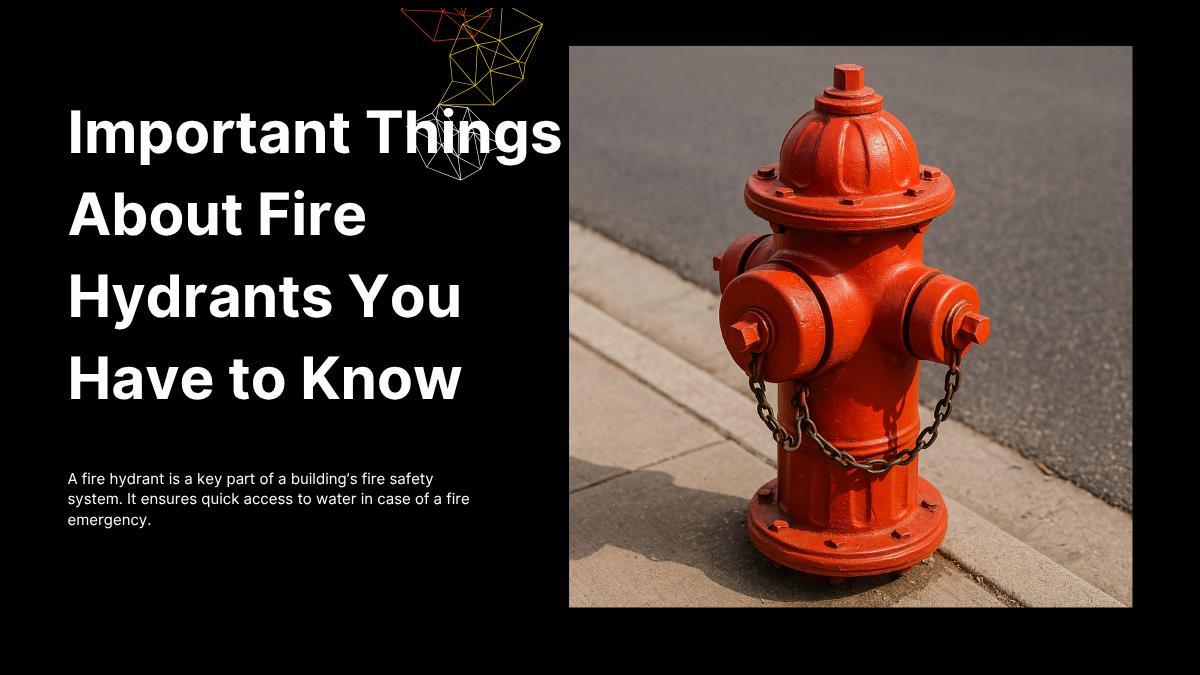A fire hydrant is a key part of a building’s fire safety system. It ensures quick access to water in case of a fire emergency.
Table of Contents
What Is a Fire Hydrant? Types, Uses, and Safety Tips
A fire hydrant is a key part of a building’s fire safety system. It ensures quick access to water in case of a fire emergency. You will often see these hydrants near streets, in parking lots, or inside large buildings. They connect directly to a water supply and help firefighters put out fires quickly. Knowing how fire hydrants work and the types available can be helpful during an emergency.
What is a Fire Hydrant and Why Is It Necessary?
A fire hydrant provides firefighters with fast and convenient access to water. It is attached to an underground pipe and supplies water to the ground when it is required. Fire hydrants provide water for the hoses used to extinguish a fire.
Fire hydrants are placed in a carefully determined location such that part of each segment of a building or street can be accessed in the event of a fire. It would be harder and time-consuming to extinguish fires without fire hydrants.
Types of Fire Hydrant Systems
There are eight kinds of fire hydrants, each one being ideal for a specific application. Identification of such varieties can contribute to better fire safety planning in buildings, streets, and open areas.
1. Dry Barrel Hydrant
The Dry Barrel hydrant is designed for cold climates where water in the pipes may freeze. In such a design, water remains underground and only makes its way to the hydrant when it is opened. This prevents ice from entering the system. It allows the fire hydrant to operate effectively in winter conditions.
2. Wet Barrel Hydrant
The Wet Barrel hydrant is used in hot climates where freezing will be irrelevant. It is always charged with water, which makes it quicker to use during emergency conditions. Each outlet can be controlled, where multiple hoses can be attached and operated simultaneously.
3. Standpipe Hydrant
The Standpipe Hydrant is located within a building that has more than one floor. It provides firefighters with an easy method of hooking up hoses within the building, particularly for high-rise buildings. This is particularly important when fires occur on upper floors, where exterior hydrants are not easily accessible.
4. Flush Hydrant
The Flush Hydrant is either installed near the ground level or buried underground. They are employed in places such as parks or open spaces where tall hydrants would be obstructive or obstruct views. They are also employed for flushing high-flow water lines.
5. Pillar Hydrant
The Pillar Hydrant is the ground-level, upright type you most likely find on streets or sidewalks. Since it is above the ground and very accessible, it is the most used type in cities and public areas. Firefighters mostly prefer these due to their fast response.
6. Wall Hydrant
The Wall Hydrant is mounted directly on the exterior walls of the building. It is convenient if there is limited space for underground hydrants or where convenient outside access is required. This is commonly applied in schools, factories, or buildings with long exterior walls.
7. Recessed Hydrant
The Recessed Hydrant is concealed below ground level. It is provided with a lid and employed when necessary. These are typically installed where over-the-ground hydrants may be blocked or damaged. For example, in factory locations or roadside zones.
8. Post Indicator Hydrant
A Post Indicator Hydrant is a hydrant installed on top of a post indicator valve. It indicates whether the valve is in the open position or closed position, and this informs the firefighters about availability, or offices where direct control over the water supply is desired.
Every fire hydrant has a specific function based on its location, weather conditions, and the requirements of the area. The appropriate type of hydrant offers better safety, convenient access, and improved response times in the event of a fire disaster.
Tips for Fire Hydrant Safety and Maintenance
To properly maintain your hydrant system in existence:
- Test pressure and water flow on a regular basis.
- Remove any obstructions or debris around the hydrant.
- Replace broken valves or ruptured pipes.
- Conduct fire hydrant exercises every few months.
- Ensure that all components meet safety standards.
If you notice a damaged fire hydrant in your area, please report it immediately.
To Sum It Up
A fire hydrant is lifesaving and property-saving equipment. Knowing how it works and what types are used makes streets and buildings safer. With different types and colour codes, the entire hydrant system is integral to fire safety. Regular inspections, drills, and effective design ensure that hydrants function properly when required.
A properly placed and functioning fire hydrant can be a lifesaver during a fire. As a homeowner, manager, or building owner, it is helpful to familiarise yourself with your local hydrant system in order to keep everyone safe.
Frequently Asked Questions
1. What is a fire hydrant necessary for?
A fire hydrant provides ready access to water for firefighters so that they can handle and extinguish fires better in case of an emergency.
2. When should fire hydrants be inspected?
Fire hydrants should be inspected and tested annually to ensure sufficient water pressure, proper functioning, and overall safety.
3. Can anyone use a fire hydrant?
No, fire hydrants can only be used by authorised individuals such as firefighters or utility personnel to avoid misuse or damage to water systems.
4. Why are hydrants coloured differently?
Hydrant colour indicates the water flow capacity, so that firefighters can immediately understand how much water is readily available in the event of an emergency.

